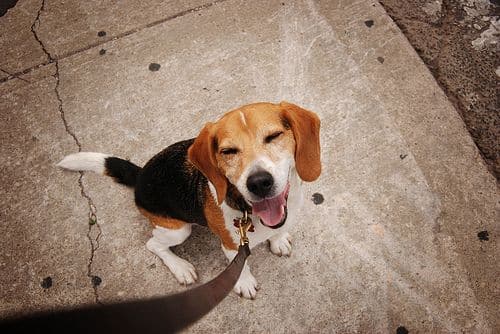Unfortunately there is a lot of misinformation about clicker training (and food-based training). While many of our new students are excited and eager to finally have a clicker training school that isn’t a two hour drive away from Downtown Toronto, some come to us a bit unsure or a bit on the fence – so if you are on the fence, this article is for you. Here are the top 7 misconceptions about clicker training that we hear when we meet new students.
Myth 1. I have to carry a clicker with me at all times or else the dog won’t perform.
Truth: Clickers are only used in the learning phase of a new behavior. After a behavior is nearly fluent, it is no longer needed.
Myth 2. If I train with food, I will need to have food with me at all times, forever, or else the dog won’t perform.
Truth: Lure-reward food-based training will create food dependency. Lure-reward training is not the same as clicker training, even though some lure-reward trainers use clickers incorrectly. Clicker trainers do not use food as a lure (or if they do, they use them extremely sparingly). If you train properly, you will not need to show your dog a treat first before it performs, nor will you necessarily have to feed your dog every time it performs. In fact, the opposite is true – if you continue to feed your dog for every correct response for too long, the dog won’t perform reliably. Clicker training actually requires you adopt what we call a variable schedule of reinforcement – in plain English, phasing out food.
Myth 3. Dogs get fat being trained with food.
Truth: Food rewards are prepared so small that they represent a relatively small percentage of total food intake per week. Also, in low-distraction environments or for easy behaviors, a dog’s regular meal can be used for training. I’ve never met a clicker trained dog that was overweight – most are pretty svelte since they often compete in dog sports as their training progresses.

Ha! Do I look fat to you?
Myth 4. If I train with food, the dog will beg for food.
Truth: Feeding your dog at the dinner table teaches them to beg at the dinner table. Giving food out by hand for no reason will teach a dog to beg for food. Training with food teaches the dog that food is only given in exchange for work performed, and only when we request the work. Well trained dogs actually never beg for food because the circumstances in which they can earn food is so black and white, they understand when it’s not available and when it’s available – and that is on our terms.
Myth 5. Clicker Trainers are “New Age-y” and “Soft” on their dogs
Truth: False!!! The best clicker trainers are extremely hard on their dogs. We are hard on the criteria we require our dogs to perform to in order to earn reinforcement. We are stingy on keeping access to rewards and reinforcement contingent on performing behaviors. Since nobody wants to carry around food forever, myself included, I use everything else that the dog wants in life to reinforce training. If my dogs don’t go into their crate and lay down, they don’t eat. If they don’t sit and stay while I open the door, the door never opens. If they don’t keep the leash loose while we are walking towards the dog park, we never get to the dog park.
What is true though is we will never use physical punishment in training because it is unnecessary – you can train reliable behaviors and proof them against distractions without having to inflict pain.
Myth 6. The dog will hear clicks from other students in class and get confused.
Truth: Dogs are experts at discriminating. Only clicks that come from the handler result in a food reward, so dogs quickly learn to ignore clicks that come from other directions.
Myth 7. Clicker training is a fad and it will be gone soon.
Truth: Clicker training comes from the work of B.F. Skinner and one of the earliest examples of clicker training was his graduate students, Marian and Keller Breland, clicker training pigeons to assist in aerial bombing in World War II. In the 1960s, Karen Pryor brought clicker training to dolphin training, and today it is now used to train practically every species of animal known to man. If it is good enough for the military and good enough for Sea World, isn’t it good enough for your family pet?
